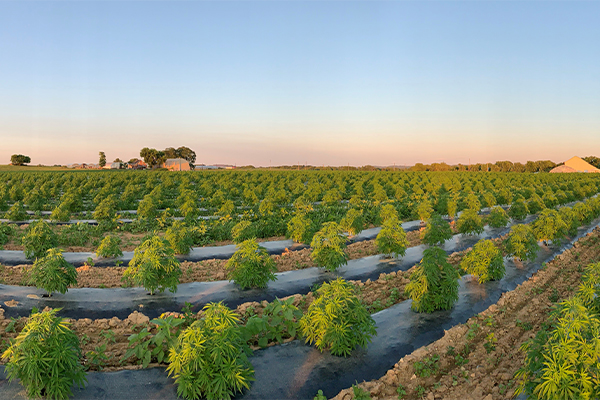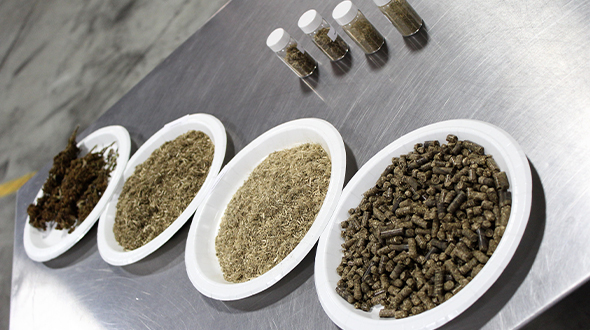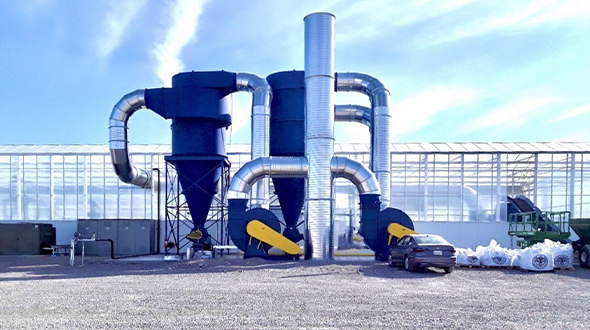Propane fuels drying process for hemp
The industrial hemp that grows across vast acres of U.S. farmland and inside greenhouses ultimately becomes myriad end-use products for everyday living.

Hemp farm photo courtesy of Sidetrack Farms LLC
From the seed, oil and fiber of the plant come food, fuel and clothing. And that’s only the beginning.
“If you can think of it, you can probably use hemp for it,” says Twana Aiken of the National Propane Gas Association (NPGA).
But before parts of the leafy green plant can be transformed into products with tens of thousands of uses, many for the consumer market, it must be dried effectively.
Enter the clean and efficient power of propane.
According to NPGA, growing hemp requires a drying process that can be served by portable propane-fueled heaters or propane-fueled greenhouses. Propane can also be used in the processing and extraction of CBD oil – often sold as a dietary supplement or included in creams and other personal care products – from hemp.
“The hemp market is a good opportunity for propane marketers to explore,” says Aiken, manager of regulatory affairs at the association, who led a webinar for the industry on the topic last summer. “The propane industry provides a clean, low cost and highly efficient option to meet energy needs.”
Propane already fuels a variety of farming applications. In 2019, the agriculture sector accounted for 11 percent of total propane sales, or just over 1 billion gallons, according to the latest data from the Annual Retail Propane Sales Report, prepared by ICF for the Propane Education & Research Council (PERC).
Propane lends itself to drying crops incredibly well, says Michael Newland, director of agriculture business development at PERC, and the opportunity for propane marketers in the hemp space is no different.
“We use propane in agriculture because it’s clean, efficient and affordable energy, and we use it across 800,000 existing farms today,” he says. “We look at the hemp space as a natural extension of propane applications within agriculture and the flexibility within agriculture.”
Hemp’s recent rise

Whether derived from the stalk, seeds, roots or leaves, different parts of the hemp plant can be used to make myriad end-use products. Photo by Michelle Banks Tice, USDA
Hemp is a federally approved commodity in the U.S., with the Department of Agriculture (USDA) overseeing production.
According to the USDA, hemp was produced in the U.S. for hundreds of years, but its usage diminished in favor of alternatives. Its production, however, has seen a resurgence in the last several years.
Farm bills in 2014 and 2018 helped pave the way for hemp production. The 2014 Farm Bill reintroduced industrial hemp production in the U.S. through state pilot programs. Production of industrial hemp beyond the pilot programs was legalized in the 2018 Farm Bill. USDA published a final rule in January of this year that provides modified regulations for the domestic production of hemp in the U.S., effective March 22.
Since the bills’ passage, planted acreage of hemp has been on the rise. Acreage reported to the USDA Farm Service Agency – zero in 2013 – increased from 32,464 acres in 2018 to 146,065 in 2019. Idaho and Mississippi are the only states not to allow the cultivation of hemp. Planting takes place between mid-May and early June, with most of the harvesting in early October, NPGA notes.
Though hemp is a type of cannabis, it contains very low concentrations (less than 0.3 percent) of THC, the chemical in marijuana that creates an intoxicated effect. Farmers must maintain those low levels of THC in the hemp to abide by USDA regulations.
Unlike hemp, marijuana – another type of cannabis – is illegal at the federal level, but more than half of U.S. states have passed laws approving it in some capacity. NPGA maintains a list of regulations by state.
Marketer experiences
Some propane marketers have already made a push into the hemp market.
Blue Star Gas installed a 15,000-gallon tank and two vaporizers for a customer in Oregon to meet demand for drying hemp.
Chris Fleming, vice president of Blue Star Gas, says the company had been “running the wheels off our trucks” to keep 1,000-gallon tanks full before installing the larger storage vessel last year.
“The total capacity or volumes are similar to other crops you see in Oregon, like peppermint, or hops in Washington,” Fleming says. “These are high-capacity propane burners and fans blowing heated air into a plenum beneath a perforated floor. The heat rises through the floor to dry the product. The volumes of fuel can be significant, and it happens in a short window of time.”
Fleming says a number of farmers switched from growing cannabis to hemp, especially in southern Oregon, after a “cannabis boom” saturated the market. He sees positive signs for the hemp market.
“With the number of uses they have for this and the amount of open land to grow it, I don’t see it stopping,” says Fleming, though he notes the business can be volatile and susceptible to the weather and moisture conditions.
In South Carolina, a challenging tobacco industry has led some farmers to consider different ways to utilize their land, says Larry Hanna of Battle LP Gas. On the NPGA webinar, Hanna recounted several farmers who decided to grow hemp. When the farmers transitioned to the new crop, the propane marketer followed suit.
“We had been positioned in the tobacco industry, so it was a natural fit for us to continue that,” Hanna shared on the webinar.
He says farmers view their propane suppliers as the experts “because we’ve been working on their tobacco for years.”
“Go visit your farmer,” Hanna says. “You would be surprised how easy it is to get them set up for drying.”
Hemp farms are located across the country but also in states where the propane industry is defending against electrify-everything movements, underscoring the need for marketers to ingrain LPG’s advantages within this customer base, NPGA shared on the webinar.
Dryer perspective

Propane industry leaders are reaching out to hemp dryer manufacturers as a way to help build out the market. Shown here is a dryer from Illinois-based IEC Thermo. Photo courtesy of IEC Thermo
While connections with farmers will help retailers cultivate relationships with ag customers, propane industry leaders are also reaching out to hemp associations and dryer manufacturers to help build out the market.
IEC Thermo, an Illinois-based hemp dryer manufacturer that offers propane and natural gas units, saw the hemp market grow quickly in 2019 after the 2018 Farm Bill.
Several years prior, Walter Hawkins was working as an independent consultant when a group approached him about drying hemp. Unfamiliar with the application at the time, Hawkins quickly learned about the plant’s extreme temperature sensitivities. Hemp, he says, can look differently depending on its genetics, the ground in which it’s grown, how it’s harvested, the weather.
“It was one of the harder dryer applications I’d ever seen,” Hawkins says. “It was quite the challenge to come up with a design that would dry biomass as wet as 80 percent moisture and never let it get hotter than 130 to 140 degrees Fahrenheit like a typical industrial dryer would.”
The sensitivities involved with drying hemp underscore the need to educate growers about the technology, Hawkins says. Education is also where the propane marketer can play a role.
“What I like about the propane side is the personalized support,” says Timothy Broderick, national director, sales and marketing, at IEC Thermo, noting his past conversations with a representative from Suburban Propane.
Broderick says having a propane company that can provide expertise about the installation, operation and mechanics of the equipment connections is critical for any drying technologies.
The company’s dryers range from 5-million-Btu models, which can burn about 55 gallons of propane per hour, to 30-million-Btu models, burning 340 gallons of propane per hour.
According to NPGA, a 100,000-Btu propane heater is ideal for aeration systems. It can dry 750 to 1,000 bushels of hemp within 24 to 48 hours. The type of hemp being harvested influences the drying process.
Codes and standards
Several existing codes address hemp farming, as well as facilities that are used for the processing and extraction of oils from plants, including cannabis, according to NPGA.
The National Fire Protection Association (NFPA) Fire Code (NFPA 1) addresses the processing of marijuana (Chapter 38), which is defined in the code to include hemp production. These requirements address the use of propane in the facility, as well as its use in the extraction process. NFPA 58, the propane code, is referenced within Chapter 38, and its general requirements would apply as well, NPGA says.
NFPA is also considering expanding the development of standards relating to the fire protection of cannabis growing and processing facilities, and is accepting comments through March 31.
The 2018 edition of the International Code Council’s International Fire Code (IFC) contains a new chapter (Chapter 39) that addresses processes associated with the extraction of oils and chemicals from plant material such as hemp, NPGA adds. Some jurisdictions enforce the IFC, which also refers to NFPA 58 where appropriate.
















